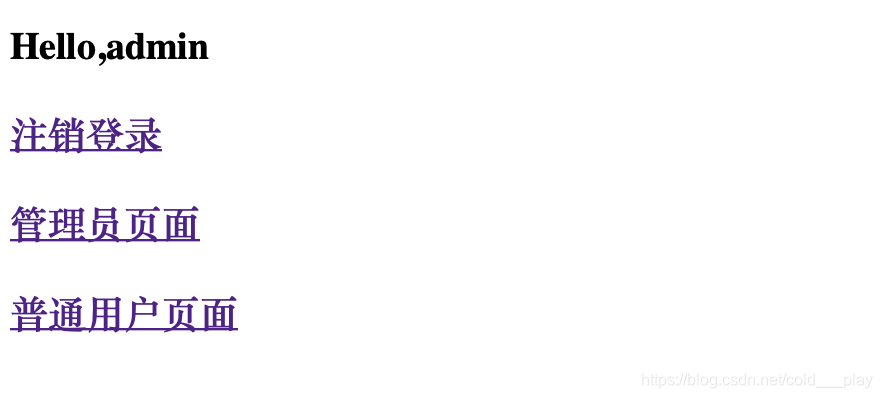创建项目,引入依赖
<dependency>
<groupId>org.apache.shiro</groupId>
<artifactId>shiro-spring-boot-web-starter</artifactId>
<version>1.4.0</version>
</dependency>
<dependency>
<groupId>org.springframework.boot</groupId>
<artifactId>spring-boot-starter-thymeleaf</artifactId>
</dependency>
<dependency>
<groupId>com.github.theborakompanioni</groupId>
<artifactId>thymeleaf-extras-shiro</artifactId>
<version>2.0.0</version>
</dependency>
注意:这里需要添加spring-boot-starter-web依赖,因为shiro-spring-boot-web-starter已经依赖了web。为了在Thymeleaf中使用shiro标签,引入了thymeleaf-extras-shiro依赖。
Shiro基本配置
在appliaction.properties中配置Shiro的基本信息:
# 开启Shiro配置,默认为true
shiro.enabled=true
# 开启Shiro Web配置,默认为true
shiro.web.enabled=true
# 登录地址
shiro.loginUrl=/login
# 登录成功的地址,默认为"/"
shiro.successUrl=/index
# 未授权的默认跳转地址
shiro.unauthorizedUrl=/unauthorized
# 是否允许通过URL参数实现会挂跟踪,默认为true
shiro.sessionManager.sessionIdCookieEnabled=true
# 是否允许通过Cookie实现会话跟踪,默认为true
shiro.sessionManager.sessionIdUrlRewritingEnabled=true
配置类:
package pers.zhang.demo.config;
import at.pollux.thymeleaf.shiro.dialect.ShiroDialect;
import org.apache.shiro.realm.Realm;
import org.apache.shiro.realm.text.TextConfigurationRealm;
import org.apache.shiro.spring.web.config.DefaultShiroFilterChainDefinition;
import org.apache.shiro.spring.web.config.ShiroFilterChainDefinition;
import org.springframework.context.annotation.Bean;
import org.springframework.context.annotation.Configuration;
/**
* @Author: acton_zhang
* @Date: 2020/2/10 9:22 下午
* @Version 1.0
*/
@Configuration
public class ShiroConfig {
@Bean
public Realm realm(){
TextConfigurationRealm realm = new TextConfigurationRealm();
//配置两个用户:sang/123 角色为user; admin/123 角色为admin
realm.setUserDefinitions("sang=123,user\n admin=123,admin");
//user具有read权限; admin具有read和write权限;
realm.setRoleDefinitions("admin=read,write\n user=read");
return realm;
}
//定义基本过滤规则
/*
"/login"和"/doLogin"可以匿名访问
"/logout"是注销登录请求
其余请求都需要认证后访问
*/
@Bean
public ShiroFilterChainDefinition shiroFilterChainDefinition(){
DefaultShiroFilterChainDefinition chainDefinition = new DefaultShiroFilterChainDefinition();
chainDefinition.addPathDefinition("/login", "anon");
chainDefinition.addPathDefinition("/doLogin", "anon");
chainDefinition.addPathDefinition("/logout", "logout");
chainDefinition.addPathDefinition("/**", "authc");
return chainDefinition;
}
//为了支持在Thymeleaf中使用Shiro标签
@Bean
public ShiroDialect shiroDialect(){
return new ShiroDialect();
}
}
Controller
配置登录接口以及页面访问接口:
package pers.zhang.demo.controller;
import org.apache.shiro.SecurityUtils;
import org.apache.shiro.authc.AuthenticationException;
import org.apache.shiro.authc.UsernamePasswordToken;
import org.apache.shiro.authz.annotation.Logical;
import org.apache.shiro.authz.annotation.RequiresRoles;
import org.apache.shiro.subject.Subject;
import org.springframework.stereotype.Controller;
import org.springframework.ui.Model;
import org.springframework.web.bind.annotation.GetMapping;
import org.springframework.web.bind.annotation.PostMapping;
/**
* @Author: acton_zhang
* @Date: 2020/2/10 9:32 下午
* @Version 1.0
*/
@Controller
public class UserController {
@PostMapping("/doLogin")
public String doLogin(String username, String password, Model model){
//构建一个UsernamePasswordToken实例
UsernamePasswordToken token = new UsernamePasswordToken(username,password);
//获取Subject对象
Subject subject = SecurityUtils.getSubject();
try{
//认证
subject.login(token);
}catch (AuthenticationException e){
model.addAttribute("error", "用户名或密码输入错误!");
return "login";
}
return "redirect:index";
}
//具有admin角色才可以访问"/admin"接口
@RequiresRoles("admin")
@GetMapping("/admin")
public String admin(){
return "admin";
}
//具有admin或user角色任意一个即可访问"/user"接口
@RequiresRoles(value = {"admin", "user"}, logical = Logical.OR)
@GetMapping("/user")
public String user(){
return "user";
}
}
对于其它不要角色就能访问的接口,直接在WebMvc中配制即可:
@Configuration
public class WebMvcConfig implements WebMvcConfigurer {
@Override
public void addViewControllers(ViewControllerRegistry registry) {
registry.addViewController("/login").setViewName("login");
registry.addViewController("/index").setViewName("index");
registry.addViewController("/unauthorized").setViewName("unauthorized");
}
}
创建全局异常处理器进行全局异常处理:
@ControllerAdvice
public class ExceptionController {
@ExceptionHandler(AuthorizationException.class)
public ModelAndView error(AuthorizationException e){
ModelAndView mv = new ModelAndView("unauthorized");
mv.addObject("error", e.getMessage());
return mv;
}
}
页面
在resources/templates目录下创建5个HTML。
index.html:
<!DOCTYPE html>
<html lang="en" xmlns:shiro="http://www.pollix.at/thymeleaf/shiro">
<head>
<meta charset="UTF-8">
<title>Title</title>
</head>
<body>
<h3>Hello,<shiro:principal/></h3>
<h3><a href="/logout">注销登录</a> </h3>
<h3><a shiro:hasRole="admin" href="/admin">管理员页面</a> </h3>
<h3><a shiro:hasAnyRoles="admin,user" href="/user">普通用户页面</a> </h3>
</body>
</html>
login.html:
<!DOCTYPE html>
<html lang="en" xmlns:th="http://www.thymeleaf.org">
<head>
<meta charset="UTF-8">
<title>Title</title>
</head>
<body>
<div>
<form action="/doLogin" method="post">
<input type="text" name="username"/><br/>
<input type="password" name="password"/><br/>
<div th:text="${error}"></div>
<input type="submit" value="登录"/>
</form>
</div>
</body>
</html>
user.html:
<!DOCTYPE html>
<html lang="en">
<head>
<meta charset="UTF-8">
<title>Title</title>
</head>
<body>
<h1>普通用户页面</h1>
</body>
</html>
admin.html:
<!DOCTYPE html>
<html lang="en">
<head>
<meta charset="UTF-8">
<title>Title</title>
</head>
<body>
<h1>管理员页面</h1>
</body>
</html>
unauthorized.html:
<!DOCTYPE html>
<html lang="en" xmlns:th="http://www.thymeleaf.org">
<head>
<meta charset="UTF-8">
<title>Title</title>
</head>
<body>
<div>
<h1>未获授权,非法访问</h1>
<h3 th:text="${error}"></h3>
</div>
</body>
</html>
测试
使用sang/123访问:
因为sang用户不具备admin角色,因此登录成功后的页面上没有前往管理员页面的超链接。


使用admin/123访问:
admin具有admin角色和user角色,所以登录成功后会显示『管理员页面』和『普通用户页面』:


使用sang/123登录后,直接访问"/admin"接口:
因为sang不具备admin角色,所以会跳转到错误页面:

